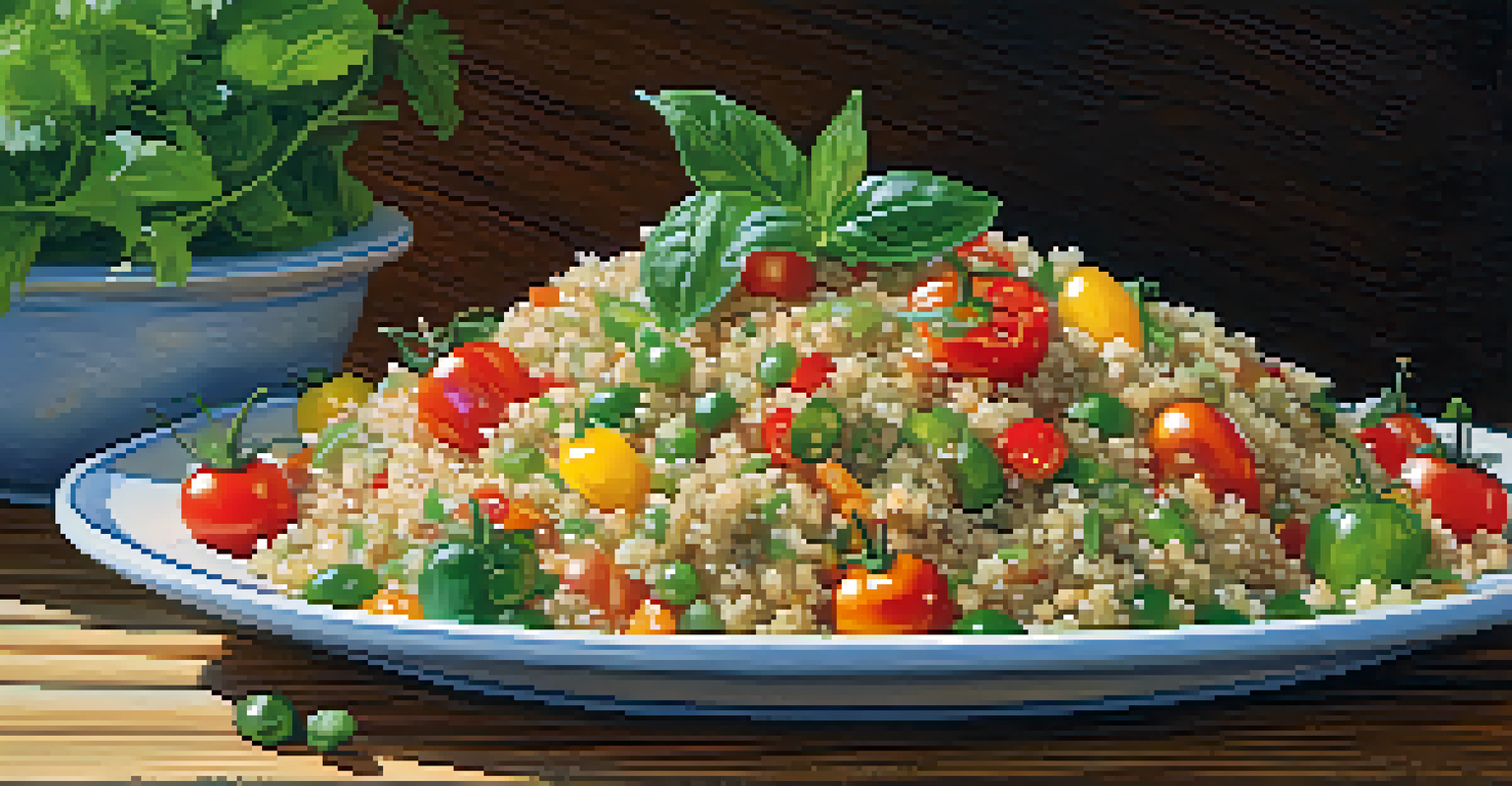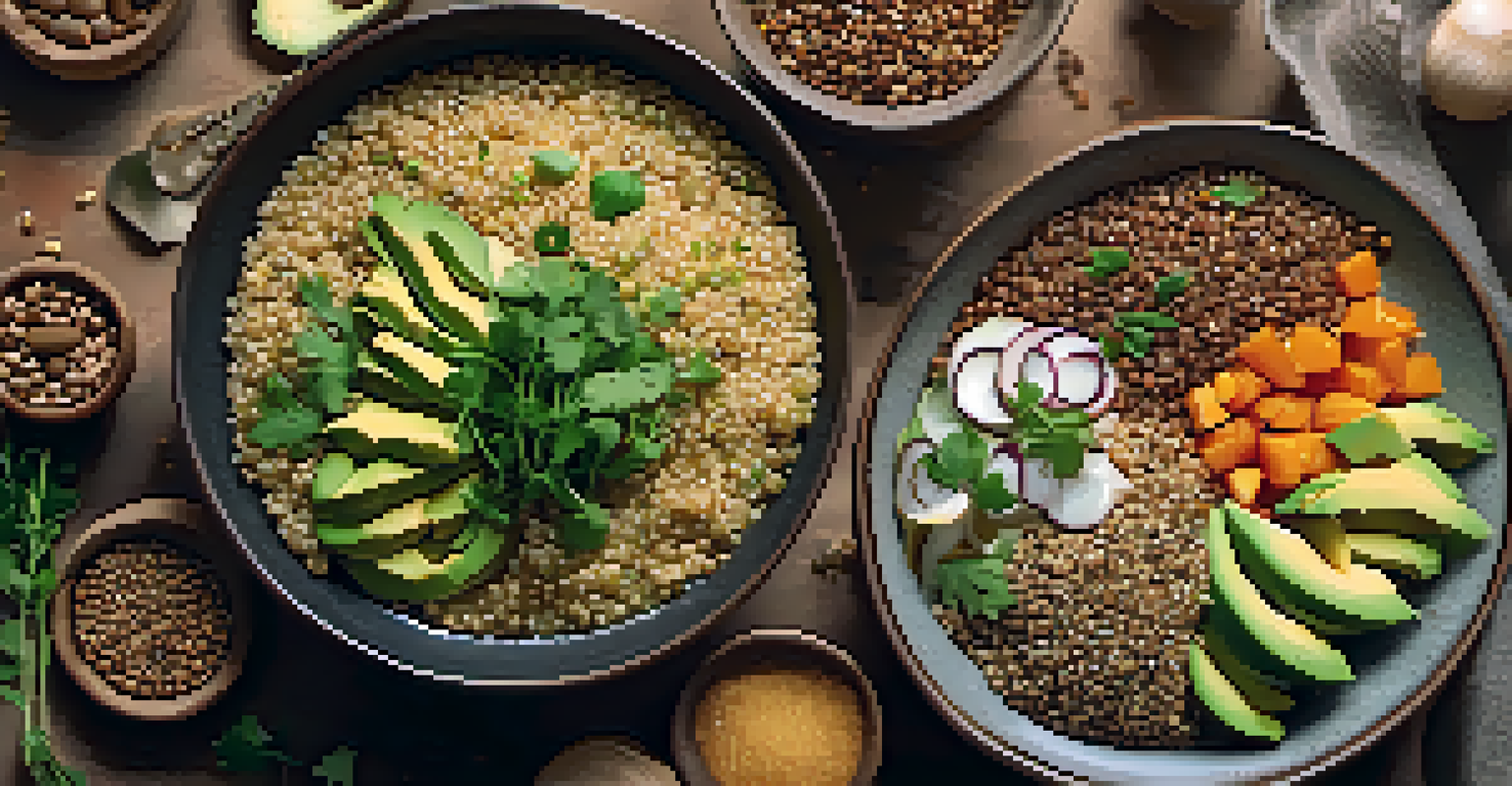The Role of Quinoa in Global Health Trends from Peru

Quinoa: An Ancient Grain with Modern Appeal
Quinoa, often referred to as a superfood, has its roots in the Andean regions of Peru. This ancient grain has been cultivated for over 5,000 years, valued by the Incas for its nutritional benefits. Its resurgence in the global market is a testament to the growing interest in healthy eating and sustainable agriculture.
Quinoa is a great example of a food that is both nutrient-dense and environmentally sustainable, making it a pivotal part of modern diets.
The unique nutritional profile of quinoa sets it apart from other grains. It's packed with protein, fiber, and essential amino acids, making it a complete source of nutrition for vegetarians and vegans. This versatility allows it to be incorporated into various diets, appealing to health-conscious consumers worldwide.
As people become more aware of their dietary choices, quinoa offers a solution for those seeking healthier options. Its gluten-free nature also caters to individuals with gluten intolerance, further expanding its reach in the health food market. Quinoa's popularity is not just a trend; it's a lifestyle shift towards better eating habits.
Nutritional Benefits of Quinoa
Quinoa's health benefits are impressive, making it a sought-after food in many diets. It is rich in vitamins and minerals, including magnesium, iron, and B vitamins, which are crucial for maintaining overall health. Additionally, its high fiber content supports digestive health and can help regulate blood sugar levels.

One of quinoa's standout features is its protein content. Unlike many plant-based foods, quinoa provides all nine essential amino acids, making it a complete protein source. This quality is particularly important for those who abstain from animal products, as it helps them meet their protein needs effectively.
Quinoa: A Nutritional Powerhouse
Rich in protein, fiber, and essential nutrients, quinoa is a complete food choice that supports various dietary needs.
Incorporating quinoa into meals can also support weight management. Its fiber and protein help keep you feeling full longer, reducing the likelihood of overeating. With the rise of health trends focusing on whole foods and balanced diets, quinoa stands out as a valuable addition.
Quinoa and Sustainable Agriculture Practices
The cultivation of quinoa is not only beneficial for personal health but also for the environment. Grown in the harsh conditions of the Andes, quinoa thrives in areas where other crops may fail, showcasing its resilience. This adaptability makes it a great crop for sustainable farming practices.
Food is a cultural artifact, and quinoa represents not just nourishment but a connection to history and heritage.
Peruvian farmers are increasingly adopting eco-friendly methods to grow quinoa, ensuring that production does not harm the land. Techniques such as crop rotation and organic farming minimize environmental impact while maintaining high yields. This approach aligns with global trends toward sustainability and responsible food sourcing.
By supporting quinoa production, consumers can contribute to sustainable agriculture and the livelihoods of Peruvian farmers. This creates a positive feedback loop, where the demand for quinoa helps to promote eco-friendly practices, ultimately benefiting both people and the planet.
Global Demand for Quinoa and Economic Impact
As the popularity of quinoa continues to rise, so does its demand in international markets. Countries around the world are incorporating quinoa into their cuisines, leading to increased exports from Peru. This trend has significant economic implications for local farmers and communities.
The boost in quinoa sales has provided many Peruvian farmers with a sustainable source of income. As they adapt to meet global demands, they can invest in better farming practices, education, and community development. This economic upliftment is crucial in rural areas where traditional agriculture may not provide sufficient income.
Sustainable Farming Practices
Quinoa cultivation promotes eco-friendly farming methods, benefiting both the environment and the livelihoods of Peruvian farmers.
However, it's essential to balance global demand with local needs. As quinoa becomes more mainstream, there's a risk of rising prices, which could make it less accessible for local populations. Ensuring that quinoa remains affordable for those who have relied on it for generations is vital for maintaining cultural and nutritional heritage.
Quinoa's Role in Health Trends and Diets
Quinoa's rise in popularity reflects a broader shift towards healthier eating trends. As consumers become more conscious of their food choices, they seek nutrient-dense options that align with their health goals. Quinoa fits this bill perfectly, often featured in health-focused recipes and meal plans.
Diet trends such as paleo, Mediterranean, and plant-based diets frequently incorporate quinoa due to its versatility. It can be used in salads, bowls, or as a side dish, allowing it to adapt to various culinary styles. This adaptability makes quinoa a staple in many health-conscious kitchens.
Moreover, the promotion of quinoa in health and wellness circles supports its image as a superfood. Social media and food bloggers have played a substantial role in showcasing creative quinoa dishes, further driving its popularity among younger generations. This engagement fosters a culture of health awareness and culinary exploration.
Cultural Significance of Quinoa in Peru
In Peru, quinoa is more than just a food; it holds significant cultural value. Revered by the Incas, it is often referred to as 'the mother grain.' This historical perspective adds depth to its consumption, as people recognize the legacy and traditions associated with this ancient crop.
Quinoa is frequently used in traditional Peruvian dishes, reflecting the country’s rich culinary heritage. From soups to stews, it plays a crucial role in local diets, showcasing its versatility. This connection to cultural identity enhances its status as a staple food in Peru, even as it gains global recognition.
Cultural Heritage and Global Impact
Quinoa's significance in Peruvian culture enhances its global popularity while fostering a deeper appreciation for sustainable food systems.
The resurgence of quinoa has sparked a renewed interest in indigenous farming practices and traditional recipes. By embracing quinoa, Peruvians are not just preserving their heritage; they are also sharing it with the world. This cultural exchange enriches global understanding of Peruvian cuisine and the importance of sustainable food systems.
Future Trends: Quinoa and Global Health
Looking ahead, quinoa is likely to continue its trajectory as a staple in global health trends. As research highlights its numerous health benefits, more people will incorporate it into their diets. This ongoing interest will drive innovation in quinoa production and product offerings.
Moreover, the push for healthier, sustainable foods aligns with the growing awareness of nutrition's role in overall well-being. Quinoa’s adaptability means it can easily fit into various dietary preferences, ensuring its relevance in an ever-evolving food landscape. As consumers prioritize health, quinoa will remain a go-to choice.

In conclusion, quinoa's impact on global health trends from Peru is profound. It represents a blend of nutrition, sustainability, and cultural heritage, making it a food that resonates with many. As we move forward, embracing this ancient grain offers a path toward healthier eating habits and a commitment to supporting sustainable practices.